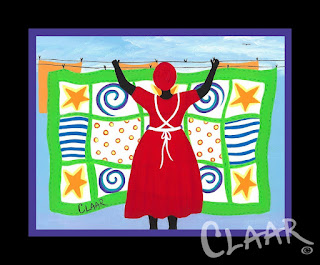As Black (ART) History month comes to an end, I thought it would be interesting to feature an artist who devotes a lot of her art subjects to the history of black women. Her name is Shonna McDaniels. (1964-)
McDaniels has a list of excellent education and credentials. The one I'd like to point out is that she is the founder and director of the Sojourner Truth Art Museum (1996-) in Sacramento, CA. She brings to this position a background as a muralist, teacher, artist and community activist. (Her murals alone number 150 as donations to the cities of Sacramento, Stockton and San Francisco.)
Much of her art of black women reaches back to Africa. McDaniels' paintings combine many African motifs including the traditional dress of women in African tribes.
When asked in an interview what draws her to Africa, she replied, in part,"...one must go back to the past, and understand the past, to have a more productive future..." This quote reminds me of Henry Louis Gates, Jr. on PBS with his show "Finding Your Roots." There is something about knowing your ancestry that informs who you are and how your ancestors have traveled to bring you to this time, this place.
When in Sacramento, do add the Sojourner Truth Art Museum to your "must see" list and enjoy history and the murals of Shonna McDaniels.


























